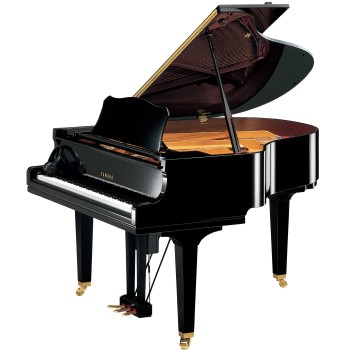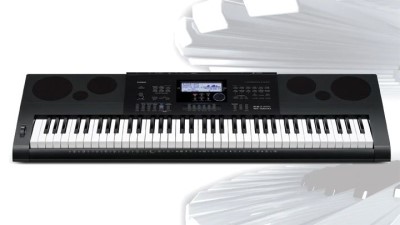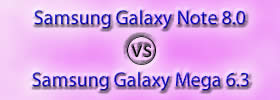Difference between Piano and Casio Keyboard
Key Difference: The primary difference between a piano and a Casio keyboard is the fact that a piano is usually quite large and difficult to move, this is mostly because it is an analog device. The keyboard, on the other hand, is quite sleek and small, especially when compared to a piano, this is because the keyboard is a modern and digital version of the piano and uses electricity to create sound.
 Piano and Casio Keyboards are two different versions of the same thing. Both are a type of musical instrument that are quite popular to play. The two are very similar as well, which is where most of the confusion arrives from. Pianos are the older and traditional version of the instrument, whereas the keyboard is the modern take on it.
Piano and Casio Keyboards are two different versions of the same thing. Both are a type of musical instrument that are quite popular to play. The two are very similar as well, which is where most of the confusion arrives from. Pianos are the older and traditional version of the instrument, whereas the keyboard is the modern take on it.
The primary difference between a piano and a Casio keyboard is the fact that a piano is usually quite large and difficult to move, this is mostly because it is an analog device which needs a lot of equipment, such as hammers, strings, levers, pedals, etc. in order to work properly. The keyboard, on the other hand, is quite sleek and small, especially when compared to a piano, this is because the keyboard is a modern and digital version of the piano and uses electricity to create sound.
There are many different types of digital or electronic keyboard instruments, including synthesizers, digital pianos, stage pianos, electronic organs and digital audio workstations. However, in essence, a digital keyboard is basically a a synthesizer with a built-in low-wattage power amplifier and small loudspeakers. Many different companies make keyboards, the most common and popular of which are Casio and Yamaha.
In a traditional piano, your key is attached to a lever which then causes a felt-covered hammer to strike the strings inside the piano. Due to this, the keys tend to feel very heavy, as the finger has to manually lift the lever. This is not the case in a keyboard; here the keys use electric signals to mimic the sound of the note on a piano, hence there are no lever to move, which is why the keys tend to be much lighter in comparison. However, a number of manufactures tend to add some form of resistance to the keys, in order to replicate the weighted keys of the piano.
 Most pianos today have a row of 88 keys, 52 white keys and 36 shorter black keys, whereas in a keyboard that varies. Some do come with the complete set of 88 keys, however, the ones with 61 keys are more common, this is because in most senariors the extreme ranges are not required. There are also smaller models available, including kids models, with even lesser number of keys.
Most pianos today have a row of 88 keys, 52 white keys and 36 shorter black keys, whereas in a keyboard that varies. Some do come with the complete set of 88 keys, however, the ones with 61 keys are more common, this is because in most senariors the extreme ranges are not required. There are also smaller models available, including kids models, with even lesser number of keys.
In terms of sound, the piano has the original and authentic piano sound, whereas the keyboard tries to mimic it electronically, which is why most traditional and classical musician still tend to prefer the piano. However, the benefit of a keyboard is that in addition to the sound of a piano, it also contains the sound of other instruments, such as organ, bass, guitar, harp, tuba, flute, etc. A keyboard may also contain features such as a headphone jack, an internal metronome, etc. This varies between make and model.
Also, pianos tend to quite more expensive than a keyboard, primarily due to the larger number of equipment needed, as well as the expertise and craftsmanship needed to make a piano. Whereas, it is quite a lot simpler to make a keyboard. A keyboard is available in various range, starting from very cheap to quite a bit expensive, however, they still tend to be quite cheaper than a piano.
Comparison between Piano and Casio Keyboard:
|
Piano |
Casio Keyboard |
|
|
Type of |
Music Instrument |
Music Instrument |
|
Medium |
Acoustic |
Electronic |
|
Power |
Does not require a power source |
Requires a power source |
|
Keys |
Weighted Keys, i.e. heavier keys |
Non-weighted keys, i.e. lighter keys |
|
No of keys |
Typically 88 keys, 52 white and 36 black |
Usually 61 keys, though 88 key versions are also available |
|
Age |
Older, more traditional |
Newer, Modern |
|
Size |
Usually huge |
Typically small and easy to carry |
|
Weight |
Heavy and bulky |
Small, sleek and light |
|
Price |
Usually very expensive |
Available in various ranges, from cheap to expensive, but will usually be cheaper than a piano |
|
Maintence |
Higher Maintenance, as a piano needs to be regularly tuned |
Lower Maintenance, little to no upkeep required |
|
Genre of Music |
Typically Classical |
Can be used for anything, classical, modern, pop, etc. |
|
Sound |
Traditional Piano sound |
Usually includes sound effects, can sound like a piano, organ, bass, guitar, etc. |
|
Features |
Not much, typically traditional |
May contain features such as a headphone jack, an internal metronome, etc. |
|
Pedals |
Typically contains 3 pedals |
May or may not come with the pedal. Some have none, some 1, some 3. |
Reference: Wikipedia (Piano, Keyboard), Take Lessons, Piano in a Flash Image Courtesy: australianpianowarehouse.com.au, casio-intl.com









Add new comment